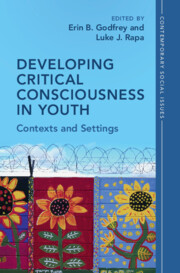Book contents
- Developing Critical Consciousness in Youth
- Contemporary Social Issues Series
- Developing Critical Consciousness in Youth
- Copyright page
- Dedication
- Contents
- Figures
- Tables
- Contributors
- Acknowledgments
- Introduction
- Part I Pedagogical, Curricular, and School-Based Contexts
- Part II Extracurricular Contexts
- Part III Societal Contexts
- Index
- References
Introduction
Introducing the Contexts and Settings of Youth’s Critical Consciousness Development
Published online by Cambridge University Press: 11 May 2023
- Developing Critical Consciousness in Youth
- Contemporary Social Issues Series
- Developing Critical Consciousness in Youth
- Copyright page
- Dedication
- Contents
- Figures
- Tables
- Contributors
- Acknowledgments
- Introduction
- Part I Pedagogical, Curricular, and School-Based Contexts
- Part II Extracurricular Contexts
- Part III Societal Contexts
- Index
- References
Summary
Structural oppression and systemic inequity are interwoven into the fabric of American society. One need only reflect on the past decade to see the continued pernicious influence of racism, sexism, classism, ableism, nativism, heterosexism, transphobia, and multiple other forms of marginalization on the rights, freedoms, and humanity of large segments of our society. We live in a system of white supremacy and patriarchy that patterns not only our history but our current society, institutions, interactions, and beliefs about each other and ourselves (Bonilla-Silva, 2006). To be Black, Brown, Indigenous, immigrant, differently-abled, gay, gender-expansive, female-identified – among many other identities – means being subjected to systems and structures that, at best, limit access to the resources and privileges others take for granted and, at worst, take away fundamental rights to life, liberty, and choice. To be white, straight, able-bodied, male-identified, and more (e.g., Christian Protestant) means wielding privilege one may or may not know one has, but that contributes to the maintenance of these inequities.
- Type
- Chapter
- Information
- Developing Critical Consciousness in YouthContexts and Settings, pp. 1 - 14Publisher: Cambridge University PressPrint publication year: 2023



